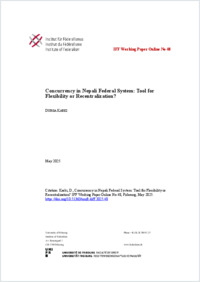Concurrency in Nepali Federal System : Tool for Flexibility or Recentralization?
BFD
- Fribourg : IFF, 2025
Concurrency
Centralization
Federalization
Nepali federal system
Exclusive powers
Distribution of powers
English
In 2015, Nepal adopted a federal system of governance abandoning the previous centralized, unitary, feudal and autocratic system to address systemic exclusion and discrimination. The Constitution of Nepal devolved state power amongst three spheres of government. Entrenched into five separate lists, these powers are both exclusive and concurrent. However, many of the powers that look exclusive at the onset are essentially concurrent due to the widespread duplication of subject areas within and across these lists. Against this backdrop, I argue that the pervasiveness of concurrency in Nepal’s distribution of powers makes it constitutionally possible for the federal government to reinforce and expand its powers. Even though a holistic reading of the constitution and subsequent legal instruments suggests that Nepal’s concurrent powers are shared and/or complementary as opposed to pure or sweeping powers, there is a lack of clarity and consistency around its meaning. The ambiguity housed by concurrency has not only served the interests of the centre, but also impeded the effective implementation of federalism in Nepal.
- Collections
- Faculty
- Faculté de droit
- Department
- Institut du Fédéralisme
- Language
-
- English
- Classification
- Law, jurisprudence
- Series statement
-
- IFF Working Paper Online ; 48
- License
- Open access status
- diamond
- Identifiers
-
- DOI 10.51363/unifr.diff.2025.48
- ISSN 2813-5261
- Persistent URL
- https://folia.unifr.ch/unifr/documents/331772
Statistics
Document views: 311
File downloads:
- 48_Durga Karki: 221
